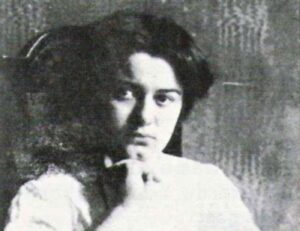Is reading well a virtue? In her 2022 book, The Scandal of Holiness: Renewing Your Imagination in the Company of Literary Saints (Brazos Press), literary scholar Jessica Hooten Wilson surveys a broad sweep of twentieth-century novels to explore whether literature can effect moral excellence in its readers. Wilson not only affirms the connection between a well-read mind and a well-formed character, but also goes one step further: a well-ordered love of literature can help us see reality better and receive the graces from God we need to become saints. As Lauren F. Winner’s foreword puts it, “Wilson thinks reading novels is actually efficacious. … [I]n Wilson’s hands, novels become a kind of sacramental.”
In unveiling what philosopher Josef Pieper calls “the core of all reality, the domain of the eternal archetypes,” good literature, like all good art, helps us to better see the real. The act of reading, done well, becomes a spiritual practice. Indeed, according to Wilson, not only is reading well a virtue, but literature itself becomes ordered to sainthood.
The Matter and Form of Reading Well
Wilson breaks up her book into thematic chapters centered around one or more texts. Though she delves deeply into the content of the novels she has selected, her core arguments treat the form of reading well, framing the act of reading itself, the way we approach the content of a great book, as an action that can become a spiritual and theological activity.
Start your day with Public Discourse
Sign up and get our daily essays sent straight to your inbox.Each of her thematic chapters includes devotional materials, study questions tailored for small group discussion, and suggestions for further reading. Like Aristotle, Wilson believes that one cannot flourish or grow in moral excellence outside a community. As she astutely observes, virtue is not formed in isolation; we will only fail if we “try to become holy without other people,” as “saints are never saints by themselves any more than a person can practice virtue on an island;” rather, “we are all called to be saints together.”
There are two necessary components for reading to become a seedbed of virtue: excellence in content or matter (what is being read) and excellence in form (how one reads). Great attention has been paid to the former in recent years. There have been numerous debates about the literary canon and the qualities shared by great works of literature. Joshua Hren’s 2022 Contemplative Realism, a book and manifesto, is a striking intervention in this debate: he traces an intellectual through-line in works of literature stretching back to the classical world. He suggests that the common thread in these works is that they seek to reveal and inspire wonder for truths, and that they prompt us to consider more carefully what the real is in both its beauty and brokenness.
There are two necessary components for reading to become a seedbed of virtue: excellence in content or matter (what is being read) and excellence in form (how one reads).
In her 2022 essay in The Point, “Art Is for Seeing Evil,” Agnes Callard advances another argument about what exactly constitutes literary form. There, she suggests that “narrative fiction broadly conceived” is for seeing evil. The best stories, according to Callard, provide readers with a training ground where they can grapple with the evils facing humanity that the modern world has so carefully attempted to bracket off from everyday existence.
Despite their differences, Hren and Callard concur on foundational points on which Wilson’s book builds. First, great literature represents and discloses reality in a deeper way than our daily experience of reality often affords; second, the narrative “matter” of a great book shapes how its readers see the world, enabling them to see more fully what is true. A great book reveals something new to us, something real, that our naked eyes couldn’t have noticed on their own.
Wilson goes beyond these debates about great literature’s matter: she also looks at the form of reading well. For Wilson, reading well is an act with philosophical and, critically, spiritual implications. Wilson, like René Girard, emphasizes the mimetic aspect of human character and imagination that are being formed (whether we like it or not) by the content of our surrounding culture, which we often unconsciously imitate. Wilson asserts that if we carelessly accept what we imbibe from our culture, we can quickly buy into ideologies that are fundamentally inhuman, the “vicious philosophy” of much modern entertainment which prizes “autonomous evaluations of value” and creates “an idolatrous imagination.”
Great literature represents and discloses reality in a deeper way than our daily experience of reality often affords.
But these dangers don’t mean that we should try to suppress our tendency to imitate. Rather, Wilson suggests that we shift from passive, uncritical acceptance of cultural mores to active formation in virtue. To do this, we need literary exemplars that do not elide the messiness of everyday reality, that depict the struggles afflicting everyone who strives for sanctity: they are neither saccharine accounts of cheap piety nor dry philosophical and moral theories.
Wilson also champions literary models of sainthood because they illustrate how a particular sinner’s journey to sainthood is a microcosm of salvation history. The “literary saints” that authors like Sigrid Undset, Georges Bernanos, Ernest J. Gaines, and Julia Alvarez offer are “ways of imagining God already at work in our hearts, present in the world, transforming and sanctifying his creation all the time,” modeled in our everyday lives. For Wilson, reading well allows good literature to transform us—through the reshaping of imaginations—into saints.
An Elusive Virtue?
Though she addresses at length the stories and the content of the books she highlights, Wilson seems to assume that readers don’t necessarily need intermediaries or guides to these texts for them to be efficacious. Wilson sees her task as exegesis, not eisegesis: she is simply explaining what is there, the reality of the texts as they are. Wilson would not claim that one would need to read The Scandal of Holiness in order to see the penetrating insights on marriage and sacrifice in Kristin Lavransdatter or to incorporate those insights into one’s own moral life—though Scandal might make doing so easier. Like Hren and Callard, Wilson sees great art as containing in and of itself that which is necessary for becoming a better person. Apprehension of beauty leads to the incarnation of the good. You cannot truly see something beautiful without its changing the way you live your life.
I desperately want this to be the case. Indeed, the Christian intellectual tradition’s brightest minds today seem sympathetic to this view, including Michael Hanby and James Matthew Wilson, the latter of whom recently remarked that “reality is always hitting you in the face,” that no predisposition can fully separate a person from the truth. But some of the finest works of art, including many of the books Wilson highlights, seem vulnerable to misunderstanding. Our imaginations are malformed and idolatrous. Probably all of Scandal’s prospective readers, me included, have had our imaginations formed by entertainment that encourages us to obsess over “our autonomous selves,” something Wilson rightly decries. Contemporary readers can even misinterpret a story as clearly concerned with redemption as Kristin Lavransdatter. Contemporary readers can misread a story as clearly concerned with redemption as Kristin Lavransdatter as “a long book about God’s disinterest in humanity in general.” How then can we assume that a novel that requires a more careful reading, such as Cormac McCarthy’s The Road (recommended but not treated by Wilson), will bear spiritual fruit for an untrained reader?
Wilson sees great art as containing in and of itself that which is necessary for becoming a better person.
Another way to put this question is: how can one cultivate the virtue of reading well by reading great books if one does not, on a certain level, know how to read well already? Likewise, though I agree with Dana Gioia’s sentiment that “you can’t force young people into literature,” that “they need to be led by pleasure and wonder,” is it necessarily true that deepening one’s literary knowledge or refining one’s literary palate through reading truly great books leads to the alteration of one’s life for the better? Why couldn’t this lead to snobbery or to a new reader becoming what Alexander Pope called a “bookful blockhead”?
These questions remain on the table. Though Wilson is quite right to say that reading groups can be communities that build up their members in virtue, groups of readers who do not know how to see a text in right relation to reality cannot be relied upon to teach each other well simply because they approach a text communally. Perhaps literary guidebooks like Scandal can start to provide the hermeneutic equivalent to corrective lenses for such aspiring readers. As Wilson stresses, however, models work best when they are living and incarnate in front of you. Wilson’s book demonstrates the great need for teachers who can exemplify virtuous reading in their local communities—but where these teachers will come from, God only knows.
The task of developing reading well as a virtue now faces the future of the Christian intellectual tradition. Though Josef Pieper—whose writings on art, contemplation, and leisure are quoted by Wilson—once famously claimed that “man’s ability to see is in decline,” Wilson’s book offers a glimmer of hope that by reading well, we can see truly again.













